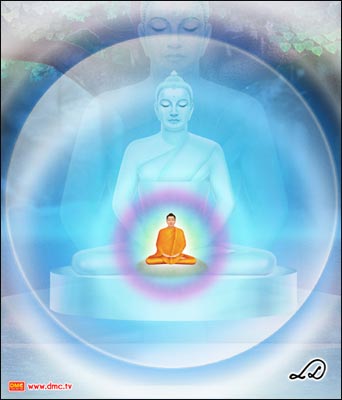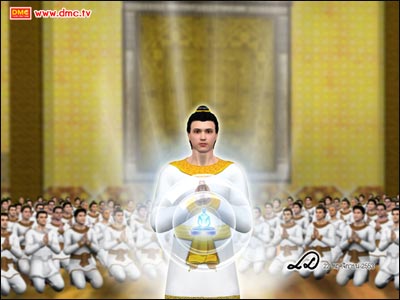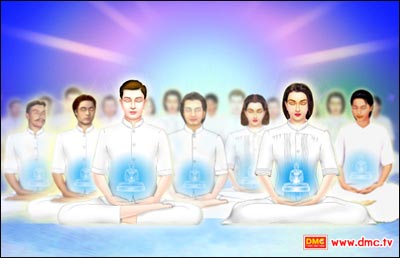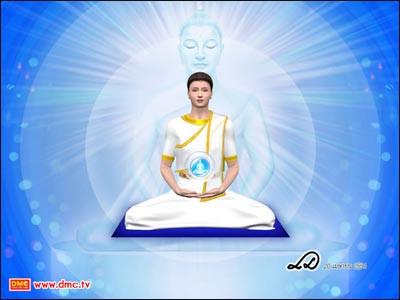Meditation for Beginners
The Noble Truth of the Cessation of Suffering # 5
The Dhamma Body is made of Transcendental Aggregates
Dhammakaya is the Body of Enlightenment
Luang Phaw Wat Paknam explained that the Dhamma Body is similar in shape and form to a Buddha image (of the sort with a lotus bud on the topknot)-but crystal clear and sparkling like a mirror – exquisitely beautiful and proportioned. The Dhamma Body is the most refined of all the inner bodies described so far and itself exists at differing levels of refinement the Coarse Dhammakaya Gotrabhu Body, the Subtle Dhammakaya Gotrabhu Body, the Coarse Dhammakaya Sotapana, the Subtle Dhammakaya Sotapana Body, the Coarse Dhammakaya Sakidagami Body, the Subtle Dhammakaya Sakidagami Body, the Coarse Dhammakaya Aangami Body, the Subtle Dhammakaya Arahant Body. From the teachings of Phrarajbhavanavisudh (Chaiboon Dhammajayo) present abbot of Wat Phra Dhammakaya the only reason that there is differentiation between the different levels of the Dhamma Bodies is because the amount of subtle defilement sthat remain for each level of Dhamma Body are different. If a large number of defilements still remain then the Dhamma Body will be the ‘Dhammakaya Gotrabhu. If defilements are relatively less then it will be the ‘Dhammakaya Sotapana’. If the defilements are still less then it will be the ‘Dhammakaya Sakidagami. If even less, it will be the ‘Dhammakaya Anagami-and if no defilements remain at all, it will be called the ‘Coarse Dhammakaya Arahant’ or the ‘Subtle Dhammakaya Arahant’ –the latter two being the bodies of enlightenment of the arahant. The Dhammakayas are all transcendental [lokuttara] is nature – that is they are not made up of conventional aggregates [knanda] but are made up of pure aggregates [dhammakhanda]-the physical form, feeling, perception, memory and cognition still exist at the level of the Dhamma Body, but they are all purified to the point of perfection. By contrast the aggregates that make up the body at the level of the human, angel, Form-Brahma and Formless-Brahma are still on the mundane level [lokiya] and lead the owner of those bodies to be reborn further is the cycle of existence.
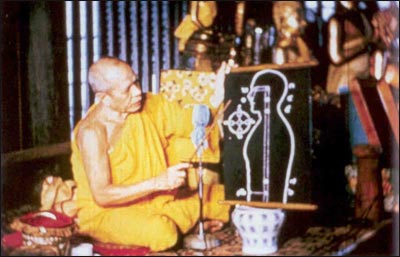
Luang Phaw Wat Paknam explained that the
Dhamma Body is similar in shape and form to a Buddha image
Meditators who channel their mind through the Middle Way at the centre of the body from the Physical Human Body to the Subtle Formless-Brahma Body are still meditating only at the level of Calm [samatha]. The eyes of these aforementioned bodies are still blind to the way in which the aggregates are subject to the Three Characteristics [ti-lakkhana]. Only when the mind can attain the Dhamma Body can one’s meditation be said to have reached the stage of Insight [vipassana]-because only then are you able to see for yourself that the aggregates are subject to the Three Characteristics of impermanence [anicca], suffering [dukkha] and not-self [anatta].
Dhammakaya is the Body of Enlightenment
The ‘Dhamma’ eye is the eye of the ‘Body of Dhamma’ which has the ability to penetrate to the truth.
What is the true meaning of ‘insight’ [vipassana] meditation? In fact insight is insightful vision or seeing things according to their true nature, seeing them thoroughly from every perspective. The ‘Dhamma’ eye is the eye of the ‘Body of Dhamma’ which has the ability to penetrate to the truth. Especially to know the origins of defilements, how they come to enslave the mind and how we can overcome them, This is a major difference from the naked (physical) eye to which the defilements are invisible. The limits of our human senses are to know the manifest symptoms of defilements – for example we realize “these are the signs of greed”, ”these are the signs of hatred”, “ these are the signs of delusion” . Human senses have no way of detecting the working of defilements, and therefore we have no way of even knowing how to start removing those defilements from the mind. It is no wonder that we lack the wisdom to transcend those defilements absolutely [samucceda-virati]-and that is why we are stuck as the victims of our own suffering without any hope of escape.
By contrast, the eye of the Dhamma Body is able to penetrate and understand the nature of all things all the way from the root of the cause to the implications of the effects – that is why the Dhamma Body is able to transcend suffeeing. Thus the Dhamma Body is what enables insight –the Dhammakaya is what ]sees’. Besides ‘seeing’ the Dhammakaya is also what ‘knows’ –furnishing a penetrating understanding by use of its ‘jewel knowing’ [nana-ratana]-to the point of liberation from those things, and attaining permanence [niccam], happiness [sukham] and true self [atta]-a true self that is the embodiment of happiness (with no trac of suffering) and unchangability. Thus the Dhamma Body is every human’s body of enlightenment. It is a transcendental [lokuttara] body which is beyond the reach of defilements. It is a body which is to be found within every one of us without exception.
It is a body which is to be found within every one of us without exception.
Meditators who attain the Dhamma Body to the degree that their mind becomes irreversibly unified with the Dhamma Body, thereby make themselves invulnerable to the action of defilements. In the past we might have been unable to give up unwholesome behaviours (such as drinking alcohol) in spite of knowing the damage it was doing to our body and mind, because of the influence of our defilements. Furthermore we might have been too lazy to do wholesome things (like practicing meditation) even thought we knew the value of doing them, because of the action of defilements. It is only by attaining the Dhamma Body in side that one can definitively overcome the action of one’s defilements-but for as long as one has not yet attained the Dhamma Body, one will be continually defeated by one’s defilements.
The Dhamma Body or the Dhammakaya is the essence of Buddhism. All of the teachings of the Lord Buddha re derived from the fact that He managed to attain and become inseparably unified with the Body of Enlightenment inside Himself, as illustrated by his exhortion:
Dhammakayo aham itipi
(My essence is the Dhammakaya)
The Dhamma Body or the Dhammakaya is the essence of Buddhism.
At that point the mind of the Lord Buddha had become definitively disconnected from all the inner bodies nested at the seventh base of the mind, from the human physical body to the Dhammakaya Anagami Body and became permanently united with the Dhammalaya Arahat, whether asleep, awake, standing, walking, sitting or lying down as the ‘arahatta samma sambuddha’.
Every teaching given by the Lord Buddha derived from the wisdom of the ‘arahatta samma sambuddha’ who had freed himself of all defilement. Whether it be greed, hatred freed himself of all defilement. Whether it be greed, hatred or delusion and all the higher and lower fetters [samyojana] with which his mind had been engrained for countless lifetimes polluting his thoughts, speech and actions – which had led to retribution and leading to his continuing rebirth in the cycle of existence – he had freed himself of all impurities in the mind. The Dhammalaya Arahat Body of the Buddha had purged himself of all defilements like gold ore which has been purified of all impurities by solvent until nothing remains but pure gold. At the point of enlightenment the Dhamma Body which is composed entirely of purified aggregates manifested itself in His mind on the full moon day of the month of Visakha. It was on this day that the Lord Buddha attained sa-upadisesa nibbana. Forty five years later when the Lord Buddha passed away (into parinibbana) he attained anupadisesa nibbana.
Meditation - Related Articles
" />
" />
" />
" />
" />
" />
" />
" />
" />
" />
" />
" />
" />

